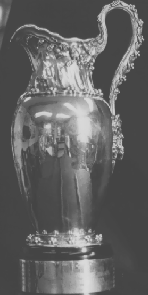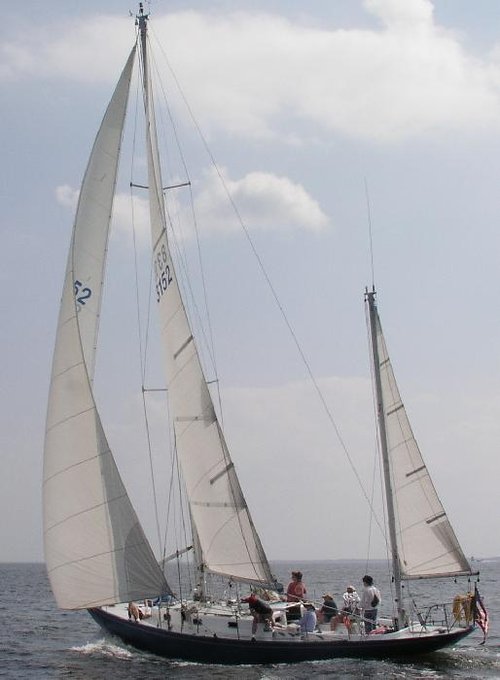FBYC History....
Jere Dennison
 No, not THAT Auld Mug...rather the prestigious Lloyd Phoenix Trophy. Lloyd Phoenix graduated from the U.S. Naval Academy in 1861, served in the Civil War, and witnessed the historic battle between the ironclads Monitor and Virginia in Hampton Roads. In 1865 he resigned his commission and became a successful businessman and yachting enthusiast. In 1910 with his most famous yacht, Intrepid, he won the New York Yacht Clubs " Cruise." The Cup he was presented was later donated to the Naval Academy and named the Lloyd Phoenix Trophy. For many years, the Lloyd Phoenix Trophy was awarded annually to the Yacht Club and Skipper winning the Lloyd Phoenix Regatta held annually in the old N.A. Luders 44 yawls for competition amongst clubs primarily from the Chesapeake Bay region. In 1986, this regatta was expanded and became US SAILINGs National Offshore Championship. In 1994, the regatta was hosted by the Long Beach Y.C. and sponsored by Disneyland, and it now alternates between the Naval Academy in odd-numbered years and the west coast in even-numbered years.
No, not THAT Auld Mug...rather the prestigious Lloyd Phoenix Trophy. Lloyd Phoenix graduated from the U.S. Naval Academy in 1861, served in the Civil War, and witnessed the historic battle between the ironclads Monitor and Virginia in Hampton Roads. In 1865 he resigned his commission and became a successful businessman and yachting enthusiast. In 1910 with his most famous yacht, Intrepid, he won the New York Yacht Clubs " Cruise." The Cup he was presented was later donated to the Naval Academy and named the Lloyd Phoenix Trophy. For many years, the Lloyd Phoenix Trophy was awarded annually to the Yacht Club and Skipper winning the Lloyd Phoenix Regatta held annually in the old N.A. Luders 44 yawls for competition amongst clubs primarily from the Chesapeake Bay region. In 1986, this regatta was expanded and became US SAILINGs National Offshore Championship. In 1994, the regatta was hosted by the Long Beach Y.C. and sponsored by Disneyland, and it now alternates between the Naval Academy in odd-numbered years and the west coast in even-numbered years.
Listed among the past winners of the trophy are such sailing luminaries as Gardner Cox, Scott Allen, Richard Lippincott, Charlie Scott, Charles Ulmer, Roy Disney, and....Johnny Hawksworth of the Fishing Bay Yacht Club.
In 1974, FBYC was invited by the Naval Academy to participate in this event along with crews from ten other CBYRA clubs. The races were always a challenge in several respects. It was difficult to assemble a sizable crew that had trained together on a regular basis; the crew would have to familiarize themselves quickly with a yacht on which they had probably never sailed before; and then races would be sailed in those lumbering beasts known as the Luders 44s in the dog days of summer at the mercy of the capricious winds and tides for which the Annapolis area is notorious. It is therefore not surprising that Northern Bay clubs, and the Annapolis Yacht Club in particular, have dominated the winners of the trophy in the past with their advantage of local knowledge.

Johnny Hawksworth was selected skipper of the enterprise to represent our Club. Johnny (Commodore in 1986) had been a top Jollyboat on the Bay for many years before moving into the offshore classes. FBYC would be represented by only seven crewmembers that included, besides Johnny, Graham Henderson, Mike Dreelin, and Wayland Rennie. Johnny recalls that "we should have had nine as a minimum, because the old 44 footers were set up for an unlimited number of cadets to support the crew. Four crew, one to release, one to help it around the mast, and two to grind normally handled the jib. Sometimes three were required to trim it quickly as the tack ended. Two could do the tweaking while the main was always a two-person job. If the wind had blown more than 15 knots, we would not have been able to sail the boat, because the main sheet was maybe 4-to-1 mechanically advantaged and the genoa winch was totally inadequate being about the size of a J24 jib winch horizontally mounted in front of the helm station. Of course no winches were two-speed or self-tailing."
The Luders 44 yawls raced in that era were overbuilt fiberglass versions of an earlier fleet of wooden Luders 44s that the Naval Academy used for training midshipmen. The boat was primarily a heavyweight offshore-capable yacht with few labor saving devices because of the unlimited number of strong backs available among the ranks of the midshipmen. Light airs with contrary tides were the nemeses of these craft, just what you would expect to encounter in July on the Northern Bay, but heavy air could physically overwhelm an undersized crew as well.
According to Johnny, he and his crew adopted an ultimately winning strategy for the Luders 44 in these difficult circumstances: "So our game plan turned out to be to get a clean start where the small crew could concentrate on sail trim and get this big hull up to hull speed as soon as possible. The mizzen sail was not used as it required another crewmember and did not give you much performance for its size on a triangular course. So we just forgot it and concentrated on boat speed and sail trim. This turned out to be a winning tactic and, as the others played with each other, we went for clean air and pulled away at the start of each race. We also used a lot of small boat tactics adapted to the yawl (hard to do with a heavy 44 footer) to maintain speed through the water by limiting quick maneuvers and used small rudder changes to maintain course. We applied telltale strings on the jib that we had to put on and take off as we rotated from hull to hull. Needless to say we found that the other crews always moved the fairleads after their race so that everything needed readjusting in the short warm-up period we had while getting used to a new boat with a race getting ready to start."
Beneath the headline Fishing Bay Wins Lloyd Phoenix Regatta, the July 22, 1974 edition of the Baltimore Sun proclaimed that "the Fishing Bay Yacht Club sailing team from Virginia yesterday won the race against the clock, the fleet, the wind and the tide, to capture the 15th Annual Lloyd Phoenix Regatta sponsored by the United States Naval Academy Sailing Squadron". The story continued to describe how the series was won.
After the first day of racing there were only three competitors out of the eleven clubs that had a reasonable chance to win the trophy: the Annapolis Yacht Club with finishes on Saturday of 1-1, FBYC with finishes of 2-3, and the Rhode River Boat Club with finishes of 4-2. And Annapolis looked favored to take it all with a halfway decent finish on Sunday.
As the article expounded, "led by skipper John Hawksworth, the Fishing Bay crew beat the 2 ? -hour time limit set for the 10-mile race by 22 seconds, and won the race by 28 minutes over its nearest competitor, the Annapolis Yacht Club, who like the rest of the 11-boat fleet were victims of tricks of the capricious wind and the powerful ebb tide."
After a fortuitous tack on the first windward leg in a dying breeze, FBYC had opened up an increasingly larger lead throughout the remaining legs of the course, which allowed our crew to just squeak under the time limit for the race. Meanwhile, what had become of the A.Y.C. boat which had only to finish in the top four to win the series? According to the Sun: "All the while the breeze was teasing some of the other boats, Wiley had his Annapolis boat within 15-feet of the finish line with enough boats under him to save the series. But the breeze let up and the tide washed him back." And Annapolis Y.C. ended up with a 6th place as a sufficient number of other competitors crossed ahead to give FBYC the Lloyd Phoenix Trophy for the first and only time in our Club's history.